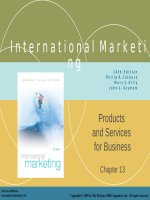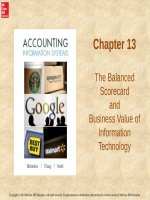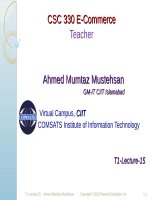Lecture E-Commerce - Chapter 13: E-commerce marketing (part I)
Bạn đang xem bản rút gọn của tài liệu. Xem và tải ngay bản đầy đủ của tài liệu tại đây (1.17 MB, 54 trang )
CSC 330 E-Commerce
Teacher
Ahmed Mumtaz Mustehsan
GM-IT CIIT Islamabad
Virtual Campus, CIIT
COMSATS Institute of Information Technology
T1-Lecture-13
T1-Lecture-12
Ahmed Mumtaz Mustehsan
Copyright © 2010 Pearson Education, Inc
T1-Lecture-13
E Commerce Marketing
Chapter-06
Part -I
For Lecture Material/Slides Thanks to: Copyright © 2010 Pearson Education, Inc
T1-Lecture-12
Ahmed Mumtaz Mustehsan
Copyright © 2010 Pearson Education, Inc
Objectives
Describe
the major B2B business models.
Recognize business models in other emerging areas
of e-commerce.
Understand key business concepts and strategies
applicable to e-commerce.
T1-Lecture-12
Ahmed Mumtaz Mustehsan
Copyright © 2010 Pearson Education, Inc
Consumers Online: The Internet
Audience and Consumer Behavior
Around
73% (86 million) U.S. households have Internet
access in 2011
Growth rate has slowed
◦Intensity and scope of use both increasing
Some demographic groups have much higher
percentages of online usage than others
◦Gender, age, ethnicity, community type, income,
education
T1-Lecture-12
Ahmed Mumtaz Mustehsan
Copyright © 2010 Pearson Education, Inc
The Internet Audience and
Consumer Behavior (cont.)
Broadband
vs. dial-up audiences, new mobile
audience
Internet purchasing affected by neighborhood
Lifestyle and sociological impacts
◦Use of Internet by children, teens
◦Use of Internet as substitute for other social
activities
Media choices
◦Traditional media competes with Internet for
attention
◦Television viewing has increased with Internet
usage
T1-Lecture-12
Ahmed Mumtaz Mustehsan
Copyright © 2010 Pearson Education, Inc
Consumer Behavior Models (basic Definitions)
Consumer behavior
◦ A social science discipline that attempts to model and
understand the behavior of human in a marketplace.
Culture
Shapes basic human values, wants, perceptions and
behaviors.
Subcultural
Subset of cultures that form around major social differences.
Direct References groups
One’s family, profession or occupation, religion, neighborhood
and schools
Indirect Reference groups
One’s life cycle stage, social class and lifestyle group.
Life-style group
An integeratted pattern of activities (hobies, sports, shopping,
likes and dislikes social events, typically attended) interest and
opinion
T1-Lecture-12 iAmed Mumtaz Mustehsan
Copyright © 2010 Pearson Education, Inc
Consumer Behavior Models
Life-style group
An integrated pattern of activities (hobbies, sports, shopping,
likes and dislikes social events, typically attended) interest
( food, fashion, family, recreation) and opinion.
Opinion Leaders (viral influencers)
Influence the behavior of others through their personality,
skills and other factors.
Psychological profiles
Set of needs, drives, motivations, perceptions, and learned
behaviors.
T1-Lecture-12
iAmed Mumtaz Mustehsan
Copyright © 2010 Pearson Education, Inc
Consumer Behavior Models
Study
of consumer behavior
◦Attempts to explain what consumers purchase
and where, when, how much and why they buy
Consumer behavior models
◦Predict wide range of consumer decisions
◦Based on background demographic factors and
other intervening, more immediate variables
T1-Lecture-12
Ahmed Mumtaz Mustehsan
Copyright © 2010 Pearson Education, Inc
Background Demographic Factors
Culture: Affects
entire nations
Subculture
◦Subsets formed around major social differences
(ethnicity, age, lifestyle, geography)
Social networks and communities
◦Direct reference groups
◦Indirect reference groups
◦Opinion leaders
◦Lifestyle groups
Psychological profile
T1-Lecture-12
Ahmed Mumtaz Mustehsan
Copyright © 2010 Pearson Education, Inc
A General Model of Consumer Behavior
SOURCE: Adapted from Kotler and Armstrong, 2009.
T1-Lecture-12
Ahmed Mumtaz Mustehsan
Copyright © 2010 Pearson Education, Inc
The Online Purchasing Decision
Psychographic Research
Combines demographic and psychological data
Divides market into various groups based on social
class, lifestyle, and/or personality characteristics
Stages in consumer decision process and supporting
communications: (Both Online and Offline)
Awareness of need
Search for more information
Evaluation of alternatives
Actual purchase decision
Post-purchase contact with firm
T1-Lecture-12
Ahmed Mumtaz Mustehsan
Copyright © 2010 Pearson Education, Inc
The Consumer Decision Process and
Supporting Communications
T1-Lecture-12
Ahmed Mumtaz Mustehsan
Copyright © 2010 Pearson Education, Inc
A Model of Online Consumer Behavior
Decision
process similar for online and offline
behavior
General online behavior model
◦Consumer skills
◦Product characteristics
◦Attitudes toward online purchasing
◦Perceptions about control over Web environment
◦Web site features: latency, usability, security
Clickstream behavior
◦The transection log that consumer establish as
they move about the web
A Model of Online Consumer Behavior
T1-Lecture-12
Ahmed Mumtaz Mustehsan
Copyright © 2010 Pearson Education, Inc
A Model of Online Consumer Behavior
(cont.)
Clickstream
factors include:
◦Number of days since last visit
◦Speed of clickstream behavior
◦Number of products viewed during last visit
◦Number of pages viewed
◦Supplying personal information
◦Number of days since last purchase
◦Number of past purchases
Clickstream marketing
◦Developed dynamically as customers use
Internet
T1-Lecture-12
Ahmed Mumtaz Mustehsan
Copyright © 2010 Pearson Education, Inc
Shoppers: Browsers and Buyers
Shoppers:
87% of Internet users
◦73% buyers
◦15% browsers (purchase offline)
One-third of offline retail purchases influenced by
online activities
Online traffic also influenced by offline brands and
shopping
E-commerce and traditional commerce are
coupled: Part of a continuum of consuming
behavior
T1-Lecture-12
Ahmed Mumtaz Mustehsan
Copyright © 2010 Pearson Education, Inc
Online Shoppers and Buyers
T1-Lecture-12
Ahmed Mumtaz Mustehsan
SOURCE: Based on data from eMarketer, Inc.,
2011d.
Copyright © 2010 Pearson Education, Inc
What Consumers Shop for and Buy Online
Big
ticket items
◦Travel, computer hardware, electronics
◦Consumers now more confident in purchasing
costly items
Small ticket items ($100 or less)
◦Apparel, books, office supplies, software, etc.
◦Sold by first movers on Web
Physically small items
High margin items
T1-Lecture-12
Ahmed Mumtaz Mustehsan
Copyright © 2010 Pearson Education, Inc
What Consumers Buy Online
Figure 6.5, Page 365
SOURCES: Based on data from Internet Retailer, 2011.
T1-Lecture-12
Ahmed Mumtaz Mustehsan
Copyright © 2010 Pearson Education, Inc
How Consumers Shop
How
shoppers find online vendors
◦Search engines—59%
◦Marketplaces (Amazon, eBay)—28%
◦Direct to retail sites—10%
◦Other methods—3%
Online
shoppers are highly intentional
◦Look for specific products, companies, services
Stumble Upon (encountered / bump into)
Recommender systems
T1-Lecture-12
Ahmed Mumtaz Mustehsan
Copyright © 2010 Pearson Education, Inc
SOURCES: Based on data from eMarketer, Inc., 2011d.
T1-Lecture-12
Ahmed Mumtaz Mustehsan
Copyright © 2010 Pearson Education, Inc
Trust, Utility, and Opportunism in Online Markets
Two
most important factors shaping decision to
purchase online:
◦Utility:
Better prices, convenience, speed
◦Trust:
Asymmetry of information can lead to
opportunistic behavior by sellers
Sellers can develop trust by building strong
reputations for honesty, fairness, delivery and
after sale service.
T1-Lecture-12
Ahmed Mumtaz Mustehsan
Copyright © 2010 Pearson Education, Inc
Basic Marketing Concepts
Marketing
Strategies and actions to establish relationship with
consumer and encourage purchases
Addresses competitive situation of industries and
firms
Seeks to create unique, highly differentiated
products or services that are produced or supplied by
one trusted firm
◦Unmatchable feature set
◦Avoidance of becoming commodity
T1-Lecture-12
Ahmed Mumtaz Mustehsan
Copyright © 2010 Pearson Education, Inc
Feature Sets
Three levels of product or service
Core product
The core benefit the customer received from
product. e.g., cell phone
Actual product
Set of characteristics that deliver the product’s core
benefits e.g., wide screen that connects to Internet
Augmented product
Additional benefits to customers beyond the core
benefits embedded in actual product.
Basis for building the product’s brand e.g., product
warranty and after sale service
T1-Lecture-12
Ahmed Mumtaz Mustehsan
Copyright © 2010 Pearson Education, Inc
Feature Set
Figure 6.6, Page 368
T1-Lecture-12
Ahmed Mumtaz Mustehsan
Copyright © 2010 Pearson Education, Inc









